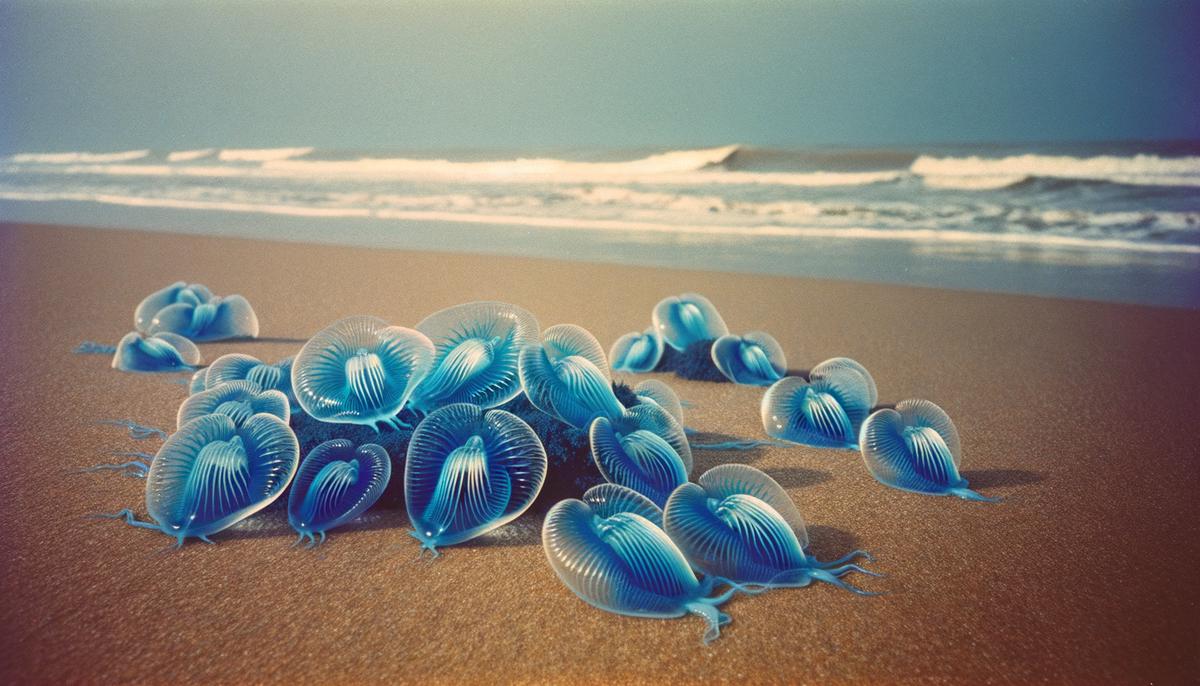When the beaches of the US West Coast start painting themselves in shades of glistening blue, it signals the arrival of the velella velella, affectionately known as 'by-the-wind sailors'. These tiny creatures catch the curiosity of beachgoers with their delicate, cobalt sails and translucent bodies. Velella are colonies of organisms functioning as a single entity, equipped with tentacles they employ to catch their microscopic prey.
While it's typical to find these creatures gracing the ocean's surface, the reasons behind their mass strandings, dubbed 'blue tides', are not thoroughly understood. Their vibrant blue hue offers possible protective measures, either camouflaging them from predators or shielding them from the sun's rays.
Traveling across vast expanses of the Pacific gyre, velella can journey from California to Central America, veering past Hawaii to reach as far as Japan before circling back. Their survival relies on the pelagic banquet available in the water column, and their life includes constant movement and boom-and-bust cycles.
Recent studies suggest an association between warmer winters and mass beaching events of velella. Warmer waters may promote the growth of velella larvae, significantly impacting their population dynamics and introducing questions about how climate change could influence marine life cycles.
As velella decompose on the shore, they cycle nutrients back into coastal ecosystems. Their strandings also provide insights into oceanic currents and health, potentially indicating shifts in our changing climate. The presence of velella reminds us of the ocean's vast network of life and the interconnected web of existence they exemplify.
The existence of velella velella defies conventional understanding of marine lifeforms. These creatures embody a fascinating example of symbiosis on the open seas. Each velella colony is a biodiverse assembly line, with specialized zones dedicated to feeding, reproducing, and navigation. This division of labor ensures the colony's survival and efficiency.
The blue hue of velella serves as an evolutionary marvel. While its purpose ranges from UV protection to camouflage, the consensus suggests it's a survival strategy, showcasing nature's way of safeguarding its creations through a balance between beauty and functional adaptation.
Scientific study of velella populations faces notable obstacles due to their transitory life on the interface between air and sea. The vast and variable canvas of the ocean renders lab-based reproduction and observation of velella communities challenging, limiting the understanding of their ecological roles and adaptative mechanisms.
Velella populations are intricately linked within the food web, acting as both predator and prey. Their diet, predominantly fish larvae and zooplankton, could hint at unexplored influences on marine biodiversity and biogeographical distribution patterns. The potential impact of velella on fish population dynamics presents an area ripe for scrutiny.
The velella velella beckon for deeper scientific inquiry. Their biology, dominated by collaborative existence and punctuated by their standout coloration, underscores the complexity of the marine world. Further deciphering their impact on ocean ecosystems and responsive patterns to climate variations could unlock new appreciations for these by-the-wind sailors and the intricately woven tapestry of marine life.

The phenomena of velella strandings invoke a deeper dialogue concerning the intricate balance of marine ecosystems. As these colonial organisms predominate the ocean's surface, their increase or decrease could significantly alter the structure of marine food webs. The consumption of fish larvae and eggs by velella stands as a critical interaction, positioning them as influential players in the ocean's biological orchestra. An abundance of velella could imply a reduction in certain fish populations, disrupting traditional marine hierarchies and potentially impacting commercial fisheries.
The implications of climate change on velella populations cannot be overstated. Warmer winters and altered oceanic currents might lead to an increase in velella strandings, signifying broader changes within marine ecosystems. The correlation between warmer seasons and the proliferation of velella might indicate shifting oceanic habitats, with unknown consequences for both pelagic and benthic communities.
Extensive strandings of velella also raise questions about nutrient cycles within coastal ecosystems. The decay of velella corpses introduces organic matter and nutrients back into coastal environments, potentially influencing local flora and fauna. This transfer of oceanic substances to terrestrial realms underscores the velella's role as facilitators of cross-system nutrient movement.
The mass beachings of velella illuminate the need for further understanding and appreciation of marine dynamics in the age of climate change. With oceans bearing the brunt of global warming impacts, the fate of organisms like velella offers a snapshot into the shifting tapestry of ocean life. These events compel a reevaluation of human interactions with marine ecosystems, urging actions ranging from greenhouse gas emission reductions to proactive marine conservation efforts.
The presence of velella velella along our coastlines is more than a call to scientific inquiry—it is a beacon, highlighting the fragility and resilience of marine ecosystems amidst changing global climates. As researchers endeavor to decipher the complex ecological narratives penned by these voyagers, the broader implications for marine biodiversity and sustainability loom large. The study of velella is poised at the confluence of scientific curiosity and environmental stewardship.
- Purcell JE, Clarkin E, Doyle TK. Abundance and distribution of Velella velella in the northern California Current during 2014. J Plankton Res. 2015;37(5):1074-1078.
- Purcell JE, Milisenda G, Rizzo A, et al. Digestion and predation rates of zooplankton by the pleustonic hydrozoan Velella velella and widespread blooms in 2013 and 2014. J Plankton Res. 2015;37(5):1056-1067.
- Flux JEC. Velella: A Neglected Genus of Floating Hydroids. N Z J Mar Freshwater Res. 1986;20(2):259-261.
Writio – AI content writer for publishers. This article was written by Writio.
